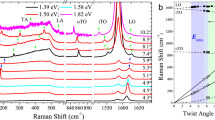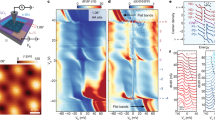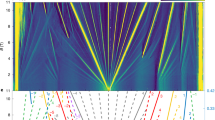Abstract
Collective excitations contain key information regarding the electronic order of the ground state of strongly correlated systems. Various collective modes in the spin and valley isospin channels of magic-angle graphene moiré bands have been alluded to by a series of recent experiments. However, a direct observation of collective excitations has been impossible due to the lack of a spin probe. Here we observe low-energy collective excitations in twisted bilayer graphene near the magic angle, using a resistively detected electron spin resonance technique. Two independent observations show that the generation and detection of microwave resonance relies on the strong correlations within the flat moiré energy band. First, the onset of the resonance response coincides with the spontaneous flavour polarization at moiré half-filling, but is absent in the isospin unpolarized density range. Second, we perform the same measurement on various systems that do not have flat bands and observe no indication of a resonance response in these samples. Our explanation is that the resonance response near the magic angle originates from Dirac revivals and the resulting isospin order.
This is a preview of subscription content, access via your institution
Access options
Access Nature and 54 other Nature Portfolio journals
Get Nature+, our best-value online-access subscription
$29.99 / 30 days
cancel any time
Subscribe to this journal
Receive 12 print issues and online access
$209.00 per year
only $17.42 per issue
Buy this article
- Purchase on Springer Link
- Instant access to full article PDF
Prices may be subject to local taxes which are calculated during checkout




Similar content being viewed by others
Data availability
Source data are available for this paper. All other data that support the findings of this study are available from the corresponding authors upon reasonable request.
References
Park, J. M., Cao, Y., Watanabe, K., Taniguchi, T. & Jarillo-Herrero, P. Flavour Hund’s coupling, Chern gaps and charge diffusivity in moiré graphene. Nature 592, 43–48 (2021).
Zondiner, U. et al. Cascade of phase transitions and Dirac revivals in magic-angle graphene. Nature 582, 203–208 (2020).
Wong, D. et al. Cascade of electronic transitions in magic-angle twisted bilayer graphene. Nature 582, 198–202 (2020).
Lu, X. et al. Superconductors, orbital magnets, and correlated states in magic angle bilayer graphene. Nature 574, 653–657 (2019).
Cao, Y. et al. Correlated insulator behaviour at half-filling in magic-angle graphene superlattices. Nature 556, 80–84 (2018).
Yankowitz, M. et al. Tuning superconductivity in twisted bilayer graphene. Science 363, 1059–1064 (2019).
Cao, Y. et al. Unconventional superconductivity in magic-angle graphene superlattices. Nature 556, 43–50 (2018).
Sharpe, A. L. et al. Emergent ferromagnetism near three-quarters filling in twisted bilayer graphene. Science 365, 605–608 (2019).
Serlin, M. et al. Intrinsic quantized anomalous Hall effect in a moiré heterostructure. Science 367, 900–903 (2020).
Chen, S. et al. Electrically tunable correlated and topological states in twisted monolayer–bilayer graphene. Nat. Phys. 17, 374–380 (2021).
Polshyn, H. et al. Electrical switching of magnetic order in an orbital Chern insulator. Nature 588, 66–70 (2020).
Lin, J.-X. et al. Spin-orbit–driven ferromagnetism at half moiré filling in magic-angle twisted bilayer graphene. Science 375, 437–441 (2022).
Chen, G. et al. Tunable correlated Chern insulator and ferromagnetism in a moiré superlattice. Nature 579, 56–61 (2020).
Xu, C. & Balents, L. Topological superconductivity in twisted multilayer graphene. Phys. Rev. Lett. 121, 087001 (2018).
Isobe, H., Yuan, N. F. Q. & Fu, L. Unconventional superconductivity and density waves in twisted bilayer graphene. Phys. Rev. X 8, 041041 (2018).
You, Y.-Z. & Vishwanath, A. Superconductivity from valley fluctuations and approximate SO(4) symmetry in a weak coupling theory of twisted bilayer graphene. npj Quantum Mater. 4, 16 (2019).
Zhang, Y.-H., Mao, D., Cao, Y., Jarillo-Herrero, P. & Senthil, T. Nearly flat Chern bands in moiré superlattices. Phys. Rev. B 99, 075127 (2019).
Chatterjee, S., Bultinck, N. & Zaletel, M. P. Symmetry breaking and skyrmionic transport in twisted bilayer graphene. Phys. Rev. B 101, 165141 (2020).
Scheurer, M. S. & Samajdar, R. Pairing in graphene-based moiré superlattices. Phys. Rev. Res. 2, 033062 (2020).
Kang, J., Bernevig, B. A. & Vafek, O. Cascades between light and heavy fermions in the normal state of magic-angle twisted bilayer graphene. Phys. Rev. Lett. 127, 266402 (2021).
Khalaf, E., Bultinck, N., Vishwanath, A. & Zaletel, M. P. Soft modes in magic angle twisted bilayer graphene. Preprint at https://arxiv.org/abs/2009.14827 (2020).
Bernevig, B. A. et al. Twisted bilayer graphene. V. Exact analytic many-body excitations in Coulomb Hamiltonians: charge gap, Goldstone modes, and absence of Cooper pairing. Phys. Rev. B 103, 205415 (2021).
Christos, M., Sachdev, S. & Scheurer, M. S. Correlated insulators, semimetals, and superconductivity in twisted trilayer graphene. Phys. Rev. X 12, 021018 (2022).
Huang, C., Wei, N., Qin, W. & MacDonald, A. H. Pseudospin paramagnons and the superconducting dome in magic angle twisted bilayer graphene. Phys. Rev. Lett. 129, 187001 (2022).
Kumar, A., Xie, M. & MacDonald, A. H. Lattice collective modes from a continuum model of magic-angle twisted bilayer graphene. Phys. Rev. B 104, 035119 (2021).
Schrade, C. & Fu, L. Spin-valley density wave in moiré materials. Phys. Rev. B 100, 035413 (2019).
Saito, Y. et al. Isospin Pomeranchuk effect in twisted bilayer graphene. Nature 592, 220–224 (2021).
Rozen, A. et al. Entropic evidence for a Pomeranchuk effect in magic-angle graphene. Nature 592, 214–219 (2021).
Liu, X., Zhang, N., Watanabe, K., Taniguchi, T. & Li, J. Isospin order in superconducting magic-angle twisted trilayer graphene. Nat. Phys. 18, 522–527 (2022).
Liu, X. et al. Tuning electron correlation in magic-angle twisted bilayer graphene using Coulomb screening. Science 371, 1261–1265 (2021).
Sharpe, A. L. et al. Evidence of orbital ferromagnetism in twisted bilayer graphene aligned to hexagonal boron nitride. Nano Lett. 21, 4299–4304 (2021).
Christos, M., Sachdev, S. & Scheurer, M. S. Superconductivity, correlated insulators, and Wess–Zumino–Witten terms in twisted bilayer graphene. Proc. Natl Acad. Sci. USA 117, 29543–29554 (2020).
Watanabe, H. Counting rules of Nambu–Goldstone modes. Annu. Rev. Condens. Matter Phys. 11, 169–187 (2020).
Mani, R. G., Hankinson, J., Berger, C. & De Heer, W. A. Observation of resistively detected hole spin resonance and zero-field pseudo-spin splitting in epitaxial graphene. Nat. Commun. 3, 996 (2012).
Sichau, J. et al. Resonance microwave measurements of an intrinsic spin-orbit coupling gap in graphene: a possible indication of a topological state. Phys. Rev. Lett. 122, 046403 (2019).
Singh, U. R. et al. Sublattice symmetry breaking and ultralow energy excitations in graphene-on-hBN heterostructures. Phys. Rev. B 102, 245134 (2020).
Wang, L. et al. One-dimensional electrical contact to a two-dimensional material. Science 342, 614–617 (2013).
Zibrov, A. A. et al. Tunable interacting composite fermion phases in a half-filled bilayer-graphene Landau level. Nature 549, 360–364 (2017).
Li, J. I. A. et al. Even-denominator fractional quantum Hall states in bilayer graphene. Science 358, 648–652 (2017).
Zeng, Y. et al. High-quality magnetotransport in graphene using the edge-free Corbino geometry. Phys. Rev. Lett. 122, 137701 (2019).
Polshyn, H. et al. Quantitative transport measurements of fractional quantum Hall energy gaps in edgeless graphene devices. Phys. Rev. Lett. 121, 226801 (2018).
Chinn, S. R., Zeiger, H. J. & O’Connor, J. R. Two-magnon Raman scattering and exchange interactions in antiferromagnetic KNiF3 and K2NiF4 and ferrimagnetic RbNiF3. Phys. Rev. B 3, 1709–1735 (1971).
Davies, R. W. Amplitude-renormalization factor in two-magnon Raman scattering. Phys. Rev. B 5, 4598–4602 (1972).
Lake, E., Patri, A. S. & Senthil, T. Pairing symmetry of twisted bilayer graphene: a phenomenological synthesis. Phys. Rev. B 106, 104506 (2022).
Wilhelm, P., Lang, T. C., Scheurer, M. S. & Läuchli, A. M. Non-coplanar magnetism, topological density wave order and emergent symmetry at half-integer filling of moiré Chern bands. SciPost Phys. 14, 040 (2023).
Acknowledgements
A.M and J.I.A.L. thank R. Cong for the critical review of the manuscript. E.M. acknowledges funding from the National Defense Science and Engineering Graduate (NDSEG) Fellowship. J.-X.L. and J.I.A.L. acknowledge funding from NSF DMR-2143384. The device fabrication was performed at the Institute for Molecular and Nanoscale Innovation at Brown University. J.P. and L.Z. acknowledge support from the Cowen Family Endowment at MSU. K.W. and T.T. acknowledge support from the EMEXT Element Strategy Initiative to Form Core Research Center by grant no. JPMXP0112101001 and the CREST(JPMJCR15F3), JST. Sandia National Laboratories is a multi-mission laboratory managed and operated by the National Technology and Engineering Solutions of Sandia, LLC, a wholly owned subsidiary of Honeywell International, Inc., for the US Department of Energy (DOE)’s National Nuclear Security Administration under contract DE-NA0003525. This work was funded, in part, by the Laboratory Directed Research and Development Program and performed, in part, at the Center for Integrated Nanotechnologies, an Office of Science User Facility operated for the US DOE, Office of Science. This paper describes the objective technical results and analysis. Any subjective views or opinions that might be expressed in the paper do not necessarily represent the views of the US DOE or the US government.
Author information
Authors and Affiliations
Contributions
J.-X.L. and E.M. fabricated the device. E.M, A.M., D.S., L.Z. and J.P. performed the measurements. E.M., A.M. and J.I.A.L. analysed the data. E.M., M.S.S., A.M. and J.I.A.L. wrote the manuscript. S.L., D.R. and J.H. provided the WSe2 crystals. K.W. and T.T. provided the hexagonal boron nitride crystals.
Corresponding authors
Ethics declarations
Competing interests
A provisional patent application has been filed in the USA. by Brown University under serial no. 18/103,290. The inventors include J.I.A.L., A.M., E.M. and J.-X.L. The application, which is pending, contains proposals of two-dimensional material architectures with controllable magnetic states and microwave resonance.
Peer review
Peer review information
Nature Physics thanks the anonymous reviewers for their contribution to the peer review of this work.
Additional information
Publisher’s note Springer Nature remains neutral with regard to jurisdictional claims in published maps and institutional affiliations.
Supplementary information
Supplementary Information
Supplementary Figs. 1–20, Table 1 and discussion.
Source data
Source Data Fig. 1
Source data for the transport measurements in Fig. 1c,e,g.
Source Data Fig. 2
Source data for the transport measurements in Fig. 2a.
Source Data Fig. 3
Source data for the transport measurements in Fig. 3a.
Source Data Fig. 4
Source data for the transport measurements in Fig. 4a,d.
Rights and permissions
Springer Nature or its licensor (e.g. a society or other partner) holds exclusive rights to this article under a publishing agreement with the author(s) or other rightsholder(s); author self-archiving of the accepted manuscript version of this article is solely governed by the terms of such publishing agreement and applicable law.
About this article
Cite this article
Morissette, E., Lin, JX., Sun, D. et al. Dirac revivals drive a resonance response in twisted bilayer graphene. Nat. Phys. 19, 1156–1162 (2023). https://doi.org/10.1038/s41567-023-02060-0
Received:
Accepted:
Published:
Issue Date:
DOI: https://doi.org/10.1038/s41567-023-02060-0
This article is cited by
-
A first-principles study of bilayer 1T'-WTe2/CrI3: a candidate topological spin filter
npj Spintronics (2024)
-
Vestigial singlet pairing in a fluctuating magnetic triplet superconductor and its implications for graphene superlattices
Nature Communications (2024)
-
Nodal band-off-diagonal superconductivity in twisted graphene superlattices
Nature Communications (2023)



